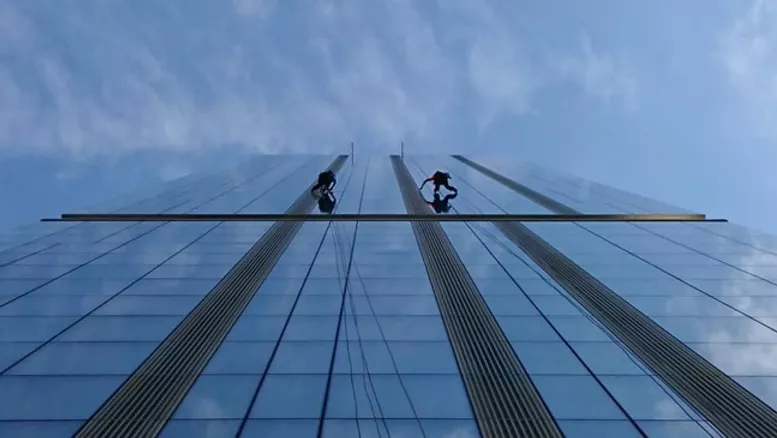We built our business on window and façade cleaning over 30 years ago, and today we still sit at the forefront of these services, proudly delivering superior window and cladding cleaning for clients old and new.
Our extensive experience, using techniques from traditional to high-tech, and the range of buildings we work on – city centre hotels to glass-fronted landmarks – makes us well-qualified to take on any cleaning challenge.
Of course, at the heart of our services and our success are the people who take on these challenges: please meet one of our technicians, Rope Access Supervisor Grady Mountfordhogg…

Does a Rope Access Supervisor abseil down buildings cleaning windows?
Ha! Yes. I do that.
How did you get into that?
I started at Tudor Group about four years ago. I had a friend at the time who was also working for Tudor, and it was the next step on the career ladder for me. I was already doing window cleaning and just progressed to the abseiling side of things.
Was it terrifying?
It was at the start; it’s not too bad now! You get used to it.
There must be special training…
Yes. All Tudor Group have to do an IRATA (Industrial Rope Access Trade Association) training course which takes five days: four days learning and then an assessment on the fifth. IRATA is a globally recognised qualification by the leading worldwide authority in rope access.
All technicians start as a Level 1 – there’s Level 2 and 3 as well. The training includes the basic principles of movement on ropes – ascent, descent, changing from ascent to descent, changing from rope to rope, crossing a knot, aid climbing and traversing, passing re-anchors and deviations, use of a back-up system, elementary rigging and rope management, elementary rescue. The assessment is carried out by an IRATA International Assessor and is in two parts: written and practical. Level 1 candidates are required to answer theory questions as well as being able to demonstrate their competency in all Level 1 syllabus tasks.
Sounds dangerous. Have you had any injuries?
No. Everything is safe. The industry has an exemplary safety record and is one of the safest methods for working at height as there are strict control measures in place.
As well as the IRATA training, all rope access technicians at Tudor Group work within strict adherence to BS 7985, the code of practice for the use of rope access methods for industrial purposes.
How does a job work? Do you assess it first?
Absolutely. Each job has its own unique requirements, so the managers do a site visit to assess each job before quoting for days, timescales and prices. Each project has a site-specific risk assessment and method statement (RAMS) which forms part of the team’s briefing and training.
And how do you do the job?
There are different competencies and methods of rigging to consider, depending on the job. As I said, every building is different: some will allow you to rig from the steelwork structure or eyebolts specifically positioned on the roof.For other buildings with no steelwork or eyebolts, we may bring our own rigging equipment such as deadweight trolleys and A-Frames. Whatever the building, there is always a solution, and safety remains the primary factor for designing a solution.
These are then rigged off them with the rigging methods that have been agreed within the RAMS, then you just come down the building, clean what you need to clean, get back in the lift, go back to the roof, move to the next bit, do the next bit, and just keep repeating that.
What different techniques or systems do Tudor Group offer?
In terms of working at height access systems, we use scaffolding, and truck-mounted access platforms where the technician is in the basket and can operate the arm to increase the height or reach awkward areas from that. At Tudor Group we offer cradle work as well – where you’re in a cradle on the side of a building.
What kind of buildings do you work on?
It varies – no two days are the same! We provide window and cladding cleaning to listed buildings and ultra modern buildings across all types of sectors, from commercial buildings through to stadia and residential blocks.
What a mad job!
It’s great. I’ve been doing it for just over four years, but it’s a young man’s game really and I’m thirty next month! The next step for me would be to become a more office-based manager.
The first time you abseiled, did you have to psyche yourself to do it?
You just try to not look down at the very start, if you’re wary of heights!
It can be a bit hairy when the weather is bad, too. Particularly when the wind picks up, but we only do what’s safe.
Finally, what’s the best thing about your job?
The views can be decent! We worked at GreenGate apartments in Manchester, and I think the tallest building was 33 floors, you could see all over to the Pennines, all over Manchester city centre. It was great.
The safety of staff and customers is paramount to us and our customers, which is why all our technicians are qualified to IRATA standards, and work within the BS 7985, ISO 45001, ISO 9001 and 14001 standards. This is underpinned by strict controls, measures and regulations within the industry, making rope access one of the safest methods for working at height.
If you have a cleaning or maintenance requirement to discuss, please get in touch on 0161 789 3550 or at sales@tudorcc.com.

